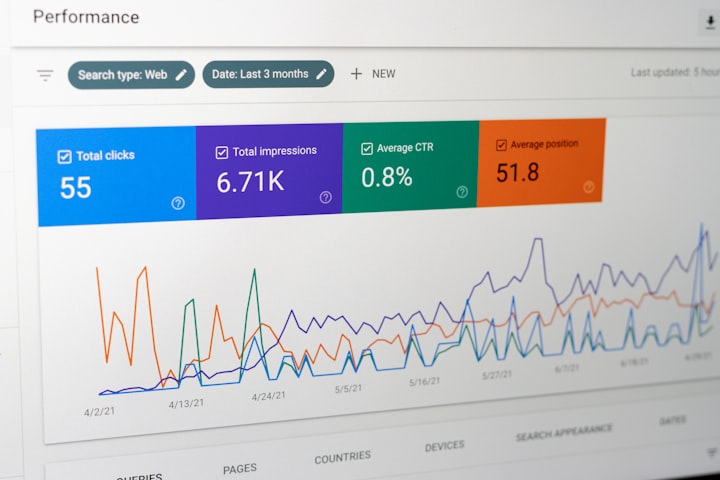3 Tips for Writing Better Articles Today
Instantly improve your writing skills

Freelance writing, as you may have noticed, is a rapidly expanding industry that's more lucrative than you may think (especially if you're good at it). Consequently, writing well-composed, engaging, and relevant material is an entirely different ball game.
A few minutes of perusing the trove of submissions on sites like WordPress, Medium, or right here on Vocal, revealed a saturation of wildly irrelevant, shallow, and poorly composed strings of words, many of which dejected my interest within the first few seconds.
But before you click away from this article, hear me out.
By no means am I the best writer to ever walk the face of the earth; far from it, actually. But if I know anything in life, it's what makes a good writer!
In the 2nd grade, my elementary school awarded me with a first place trophy and a blue ribbon. My story "The Enchanted Forest" had been selected as the winner in a Creative Writing Contest on a National level. I was 6 years old.
My name was consistently positioned at the top of the high honor roll chart through grade 8. And between grades 2 & 6, I was placed in a Gifted Arts classes (the brightest of only 4 in the county) and labeled as a young leader, a master, a prodigy.
If you'll pardon the braggard-like tone, what's important to note here is that I know my shit (writing, that is) and I've honed my skills for the better part of 30 years. The point is, creative writing and language have been a burning passion of mine since early childhood, and it shows in undeniable ways.

I have a gift and I'm very proud and excited that this gift has provided me with opportunity after opportunity to earn a wonderful income by positively impacting the lives of others in the most powerful way known to man: language.
Don't get me wrong, there are some inspired writers on these platforms and others. But some of their masterful work (mine included) can become buried deep in the assembly line of fluff some non-writers are flooding the space with — unconcerned with offering true value while choosing to sacrifice quality in the name of making a quick buck.
No shade. This approach is their idea of the most profitable option and while some may truly feel in their heart of hearts that they're putting out relatable, engaging, and relevant content, my professional opinion is that it's high time those of us who've mastered this art share our secrets with those who aspire to not only improve their writing comprehension and skills, but who desire to earn a stable income while making a positive impact.
Step 1: Select A Topic
Who is your target audience?
Before you ever stroke those blessed keys, it's critical that you determine what you want to write about and who you expect to find value in it. Yes, you can search up the most popular topics or borrow ideas from others. But experience has taught me that inspired writing is the best form of writing.
Inspired writing means you received an idea and felt eagerness, joy, or an adrenaline rush at its conception. It means as you're writing, your entire body is vibrating with high positive energy and you're actually excited to get this information out because you know there's enormous power & resonance in your message.
Your perspective of life is unique, as are your knowledge, skills, and beliefs. What do you know so well that you could talk about it nonstop? That is what you should write about. That is what your target audience wants to hear.
Your target audience is comprised of those individuals who have interest in your topic. Consider for a moment who that person is. Who is finding value in your message? What is their age? Gender? Occupation? Developing a clear idea of who your target audience is will streamline your writing style to appeal only to those who are most likely to take positive action with it (a like, a share, and a comment).

What are you saying to your target audience?
The purpose of identifying your target audience prior to writing is to ensure your topic ticks 3 specific boxes:
1. Is it Relevant?
2. Is it Relatable?
3. Is it Readable?
How often have you read an article on a topic that is of no interest to you? How often have you read and supported something you had trouble relating to? How often have you read something that was riddled with spelling errors, contained punctuation oversights, or was in a language you didn't know? Hardly ever, right.
Knowing who your target audience is clarifies to you what information would offer the most value to them. The content must always be relevant to the person you expect to read it. Predicting this can be tricky and, if it's challenging for you, helpful tips can be found here.
Relatable means if your expected readers are to find enough value in your content to read to the end, they must find relatability in your message. For instance, a new mother would find the most value in content around motherhood, childcare, and saving money on items like formula or diapers but would find little value in The Joys of Beekeeping, for example.
Content that is readable has a certain cadence, a flow, a life of its own. A readable blog will allow the reader to move with the flow of the story or topic and, in the end, feel satisfied and eager for more. If content is not easily readable, it will be left on read (and not in a good way).

Why is this information valuable?
Once you know who your target audience is and you've identified what to say, the next step is to determine why this information is valuable. See, it's one thing to know what to say or how to say it, but it's the why that truly matters, and not just in writing.
If someone wants to break up with you, you want to know why. If your job decides to lay you off, you want to know why. If someone doesn't like you, you say you don't care in public but the burning desire to know why eats you up inside. It's easy to see that the why matters.
When I pondered why this information I'm sharing today is valuable to writers, the answers came to me easily:
- It offers tips you can implement today to improve the quality of your content.
- It teaches you an easy way to earn an income as a writer even if you have no natural gift for writing.
- It improves the overall quality of content on our platforms of choice (which offers more relevant, relatable, and readable content for us all).
So consider why the information you want to share is valuable to your audience. This is the best way to predict how well it will be received and how profound the impact will be.

Step 2: Create An Outline
Imagine a contractor attempting to build a home without constructing the frame or foundation first. Or what if Mercedes-Benz decided to assemble a new vehicle without first putting together the metal frame. It's clear neither of these are logical (or safe) decisions and, in writing, your outline is your frame.
Anyone who has taken a Writing, English, or Language Arts class can tell you the outline is what makes writing easier & more organized. The outline helps arrange your thoughts in a coherent manner and creates the flow of the article by introducing your topic, moving smoothly from one subheading to the next, and wrapping it up with a solid conclusion.
There are many ways to construct an outline depending on what type of content you're writing. For the purpose of blogs or articles, let's briefly look at the 3 primary components of a good essay-style outline.
1. Main Idea: This is both your brief introduction to the topic as well as a quick mention of the upcoming points to discuss.
2. Main Points: There should be no less than 3 main points to address in your piece. You can have more if you want a longer article, but 3 is recommended.
3. Conclusion: The end is where you briefly touch on what was discussed, solidify why it's helpful, and include your call to action (if necessary) or cliffhanger (if it's a series).
Although this is by no means the be-all end-all of outline structures, it is the exact template I leverage when writing every blog or article I post (including this one). At times, I add supporting information to my main points to explain in more detail. But if you pay close attention, you will see this article follows that identical flow.
When it comes to the amount of words (in terms of length) of your piece, my rule of thumb is 500 or more. Anything shorter and you run the risk of your content being perceived as poor in quality or irrelevant. In writing, longer is better. After all, people are out here reading books with 500 pages back-to-back like it's nothing. Don't sell yourself short. Write, write long, and write well.

Step 3: Apply Pressure—Consistency
What is your ultimate goal in writing?
Now that you have your topic, you've identified your target audience, and created your outline, it's time to write! But hold on a second, just before you start, it's important to set goals (plural) so you know what you aim to achieve, how long you expect it will take to accomplish, and the path of least resistance to get you there.
Think about your goals for a year (12 consecutive months). What is your ultimate goal? Five hundred blogs a year? A thousand? More? Setting a primary goal will help your intermediate goals leading up to the primary goal to be more practical.
How many blogs do you commit to writing per day?
With your primary goal set, it's easier to break that down into smaller (intermediate) goals. For example, if you decide to write five hundred blogs in a 12 month period, calculate how many you'd have to write per month to reach that goal. To reach the answer, we divide 500 by 12, which equals about 42 (rounded up) per month.
Further broken down—for those who plan to write about 20 days per month, for example—using the same formula (42 divided by 20 days per month) we find you only need to write 2-3 blogs per day for 20 days over the next 12 months to achieve your goal of 500 blogs for the year.
Quick! Pay attention to how that feels. It feels doable, doesn't it? It feels possible. You can write 2 blogs per day easily, can't you? Especially now that you know how to write better articles. Now you're getting the hang of it.

Which inspired topics can you list to write about?
One practice that has been the key to my unique and engaging writing style (aside from my witty & charismatic personality) is writing down EVERYTHING! When I say 'everything', I'm referring to inspired topic ideas I receive throughout my day.
One Note has been my app of choice for capturing these ideas but you're free to use whichever app works best for you. The plan is, as soon as you are inspired with an idea for a topic to write about—before you judge it or overthink it—stop what you're doing and take note of it. Adding a few details to help you remember later on when the inspiration passes will be helpful as well.
Doing this over the past month alone has accumulated 60 powerful topics for me to write about (and I add to this list daily as I am inspired with more ideas). This is why—if you've never seen my work before—you are seeing it now. It's all because I committed to not only talking about how to achieve more success through writing quality content, but to prove it by doing it myself.
After all, results sell. That is to say, if you accomplish something for yourself, and you can show others not only how you achieved results but are able to teach them how to do it as well, you won't have room to receive the abundance of readers who will read, love, support, and share your content. It is Law.

Bonus
How do I stay inspired to write?
The most common complaint I hear (and read) from my fellow writers is difficulty with remaining inspired to write. Burnout, writer's block, and fatigue are emotions I never experience and this is due to one key decision I make every single day.
As a Professional Alignment Consultant, it is literally my job to guide my clients into (or back into) alignment with their Highest Calling; their Divine Purpose. For this to be possible, I must first be aligned. In order to be an inspiration, I must be inspired. For it to work any other way would defy Law.
Staying inspired, for me, is easy. By listening to inspirational audio, reading books on success, alignment, and other topics that interest me, I absorb information that those who aren't consistently doing what I do on a daily basis just won't know.
And since I'm a Teacher at the core of my being, my articles—although fun, engaging, and sometimes a bit profane—are all written from the perspective of a knowledgeable teacher to a willing pupil. This way, my target audience receives the value they expect to get—from the introduction, to the main points, to the conclusion—and I receive the joy of doing what I love most: writing.
In other words, you stay inspired by making a decision to be a sponge for inspiration. Seek out things that inspire you. Read more books on success and mindfulness. Becoming inspired is the only way to be an inspiration to others.

All-in-all, freelance writing can be an adventurous and profitable field for any writer to flourish & bloom in. Master writers, intermediate writers, and even beginner writers who possess the desire to write but who have no natural gift for writing, can instantly improve your writing starting today.
By selecting a topic that inspires you, creating a clear outline to follow, and applying pressure through consistency, success as a writer is guaranteed to not only find you but cozy up to you and stick around for as long as you keep it up.
Visit our website to show support and learn more about how we empower writers, entrepreneurs, and business professionals from all industries to be successful in everything you love to do. Your success is our business.
About the Creator
Meg Thee Tiger
Self-published erotica short story author, blogger, and professional writer proficient in technical, creative, transcription, content, copywriting, and more.






Comments
There are no comments for this story
Be the first to respond and start the conversation.